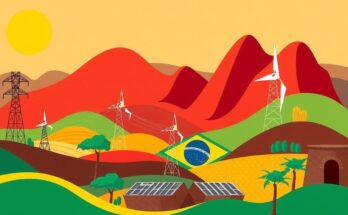The abandoned Panguna mine in Bougainville, Papua New Guinea, faces long-term environmental cleanup following a recent independent assessment. Communities seek justice for decades of damage attributed to the mine’s operation by Rio Tinto. Key stakeholders are now advocating for immediate remediation and equitable solutions to the environmental and health issues faced by local residents.
Local communities in Papua New Guinea’s Bougainville region are beginning to see progress in securing environmental justice due to a recent independent assessment of the abandoned Panguna copper mine. This mine, once among the largest globally, has been the center of landowner grievances for 36 years regarding environmental damage. The assessment has raised expectations that Rio Tinto, the former majority owner, will contribute to remediation efforts.
Bougainville’s President, Ishmael Toroama, expressed optimism about moving forward, stating that the report is a significant milestone that helps build a stronger future. Blaise Iruinu, a local chief and member of the oversight committee, shared the sentiment of looking forward to tangible actions stemming from the report.
Historically, landowners were not adequately consulted during the mine’s establishment, which began in the mid-twentieth century under Australian administration. Rio Tinto’s subsidiary, Bougainville Copper Ltd (BCL), operated the mine from 1972 until it closed amid civil unrest for environmental and equity-related disputes in 1989.
Although neither legal mandates nor comprehensive impact assessments existed at the time, Rio Tinto signed agreements intending to protect and remediate mine-affected land, but these commitments were not met. The mine produced substantial tailings waste with serious environmental implications.
In 2016, Rio Tinto divested from the mine, denying responsibility for environmental damage. However, the local populace contested this stance and, with the aid of the Human Rights Law Centre, filed a complaint in 2020 regarding the company’s failure to uphold its corporate responsibilities as per OECD guidelines.
The initial report by the Human Rights Law Centre shows that over 25,000 residents near the mine face health issues linked to water and food contamination. The mine’s operations have left legacy damages that undermine residents’ rights to health, adequate food, and safe housing.
After talks with community representatives and governments, Rio Tinto agreed to fund an independent impact study, which commenced in 2022. The subsequent Phase 1 Impact Assessment revealed dangers from the mine’s decaying infrastructure and contamination of vital water resources, urging immediate intervention.
Kellie Parker, Chief Executive of Rio Tinto Australia, emphasized the company’s commitment to engage with local stakeholders to devise a remediation plan. Keren Adams from the Human Rights Law Centre called for urgent actions to ensure community access to safe water and stabilize hazardous locations.
Professor Peter Erskine highlighted that a sustainable cleanup aligned with best practices would necessitate landowner collaboration and could span over a decade, incurring costs of billions. As Bougainville aims for nationhood, the mine’s rehabilitation remains crucial for economic viability.
Further, BCL, now majority-owned by local stakeholders, anticipates potential revenues from renewed operations. Bougainville’s leaders are eager for Rio Tinto to fulfill its obligations, and community advocates stress the imperative for equity in addressing the mine’s historical impacts.
The ongoing environmental remediation efforts in Bougainville following the assessment of the Panguna mine signify a crucial step toward restoring community health and safety. With local leaders advocating for collaboration with Rio Tinto, the focus shifts to addressing the legacy issues tied to the mine’s operation. The reclamation of environmental integrity and community well-being will require long-term commitment and collaboration among all stakeholders involved. The path forward necessitates both immediate actions and a sustainable approach to restore and secure the rights of the affected communities.
Original Source: www.globalissues.org




